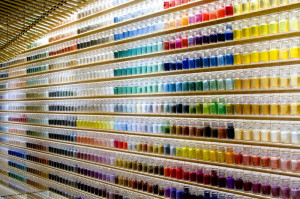
Colour infuses life and vitality to every day materials and makes them attractive and appealing. The natural burst of colourful flowers and varied hues of green in summer to the contrasting shades of orange and yellow in autumn, the colour in nature makes impressionable prints on our mind. How do we perceive colour? We hardly give it a thought!
Mystery of Colours
Most often than not, colourful organic molecules have conjugated or aromatic structural systems with a single bond, double bond arrangement wherein the electron density is spread out. The electrons are engaged in a tizzy dance along the hydrocarbon chain or about the aromatic ring to form ‘resonance structures’. Hence, very less light energy is required to send the electrons in a greater tizzy and get them more activated. Molecules which are naturally occurring easily absorb distinctive and specific wavelengths and reflect colour that is not absorbed by them. The colour that is reflected by them into the environment is viewed as the colour as seen by the human eye. For example:
- Carrots, pumpkins and squash is seen as orange in colour due to the presence of ‘beta-carotene’. This biochemical absorbs blue light and reflects orange which it does not absorb.
- Tomatoes are viewed as bright reds because the lycopene in them takes in green light and reflects red wavelengths into the atmosphere.
- Chlorophyll in plants absorbs red and blue wavelengths of light and reflects green light back to us.
The colour that is visible to the human eye is basically what is not absorbed by the organic molecule.
Dyes and Pigments- Classified
In this context, pigments can be defined as material that changes the colour of transmitted light due to the selective absorption of wavelengths. Both pigments and dyes are seen as coloured items because of the greater absorption of some wavelengths over the others. Dyes and pigments are often classified based on particular groups of atoms present in their molecular structures. Dyes are also classified based on the way they work or the manner in which they are used. For example; reactive dyes are named such as they react with the material they are supposed to colour by developing covalent bonds with it. On the other hand direct dyes are used directly from a sodium salt bath. Textile dyes are named such as they are the ones which add colour to yarns, fibres and fabrics. Acid dyes are those dyes that are applied from acidic dye baths.
Another classification of coloured chemicals is the organic and inorganic dyes and pigments. Pigments are available in solid form whereas dyes are referred to as coloured liquids. Sometimes there is a combination of organic pigments with inorganic substances and the resultant are ‘lakes’. The resultant product becomes insoluble in water and this ensures that the colour does not rub off onto human skin when used for candy and pill coatings. Organic pigments can be naturally occurring or they can be synthetic organic pigments. Among the synthetic organic pigments about 25% are the phthalocyanine pigments.
The various names that are included in the dyes and pigments all together go to make the world a vibrant place to live!